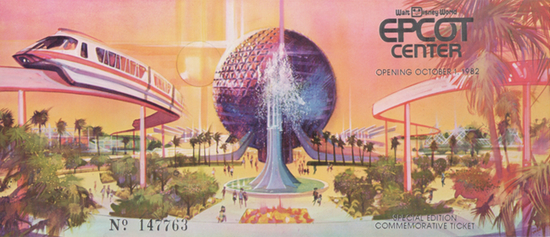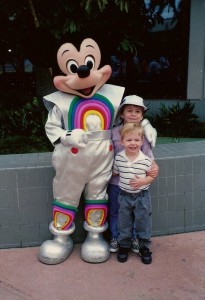Revisiting Epcot Center on its 30th Birthday
Has the Disney theme park outlived its purpose as a monument to science and technology?
![]()

Commemorative ticket from EPCOT’s opening day on October 1, 1982
EPCOT Center opened on October 1, 1982 as the single most expensive private construction project the world had ever seen. It was immediately viewed by Disney purists as a shadow of Walt Disney’s utopian dream to build a dynamic city of technology and innovation. EPCOT was originally supposed to be a real city; alive with mass transit systems, a vibrant city center and a healthy dose of residential life. Corporations, as Walt explained in a 1966 film produced just a few months before his death, were to use Epcot as a proving ground for new innovations. One imagines this might include new chemical solvents or food additives aside from the more obvious examples of postwar gadgetry like small appliances and robot maids.
Disney believed that by the mid-1960s urban America was beyond repair and that the answer to our nation’s problems lie in starting from scratch. A new city was to be built with the interests of both massive multinational corporations and pedestrians in mind. But after Disney’s death in late 1966, the vision for “the Florida Project” was scaled down dramatically. Instead, EPCOT — the Experimental Prototype Community of Tomorrow — became a theme park. This theme park was to be a permanent World’s Fair at the end of the World Fair’s golden age.
But if you could get past the fact that it was just a theme park, and not a radical experiment in building a futuristic city from the ground up, Epcot was still pretty neat. It’s a sprawling park divided into two parts: Future World and World Showcase. Future World purports to show off the latest in science and technology and has pavilions dedicated to such topics as energy, the ocean, agriculture, transportation and space. While World Showcase includes pavilions featuring various countries from around the world, including Norway, Mexico, Japan and Germany among others.

Your humble blogger with his younger brother Jason and Mickey Mouse at EPCOT (circa 1989)
I’d argue that Walt Disney World’s Epcot (it’s no longer an acronym) is an important bellwether of America’s comfort with science and technology. Today, a trip to Disney World is a rite of passage for many American families. Epcot, one of the four theme parks that comprise Walt Disney World, is the third most visited theme park in the United States. Only Disneyland in Anaheim and the Magic Kingdom in Orlando (another Walt Disney World park) surpass it in attendance. This place of prominence in the American psyche means that at its best Epcot should function as a kind of ever-changing monument to science — much in the same way that the great American World’s Fairs of the last century did.
My first trip to Epcot was in 1989 at just five years old. I’ve quite literally grown up there, having been numerous times since. My parents and two brothers have made it a habit to dissect the minute changes that take place in the park each year, but as I step back and take a more distanced view of this admittedly artificial environment that I’ve grown up with, I become concerned for what it means to Americans as a reflection of what we value.
With kids competently pushing pixels on their parents’ iPhones before they can even speak, what kind of role does Epcot play in the education of the American family? What does the pathetically static exhibit Innoventions communicate to kids about the future of technology in a theme park that purports to be about the future? Does Epcot offer the latest in technological wonders that it promised when it opened in 1982? What kind of tone does Epcot set for science education in this country? And am I overthinking what is supposed to be an entertaining experience for people?
I credit Epcot with introducing me to retro-futurism — exploring how generations of the past viewed the future. It was in the early 1990s (when I was still a kid) that I started to think of Epcot as retro-futuristic. I hadn’t yet heard such a word, but I knew even then that Epcot was a vision of the future from the past. The monorails and the Dippin’ Dots and the silver rainbow jumpsuits didn’t represent the futuristic world of 50 years hence, it was the Mickey Mouse future as imagined in 1982.
The last time I visited Epcot (in 2010) the Innoventions pavilion in the heart of Epcot showcased Segways as the hot transportation technology of the future. But of course you’re more likely to hear the word “Segway” used as a punchline than see it as a practical mode of transportation these days. When Segways represent the future of transportation a decade into the 21st century, you begin to wonder where the last ten years went. And how Epcot, a place of tremendous nostalgia for me, can become a symbol of the future again.
/https://tf-cmsv2-smithsonianmag-media.s3.amazonaws.com/accounts/headshot/matt-novak-240.jpg)
/https://tf-cmsv2-smithsonianmag-media.s3.amazonaws.com/accounts/headshot/matt-novak-240.jpg)